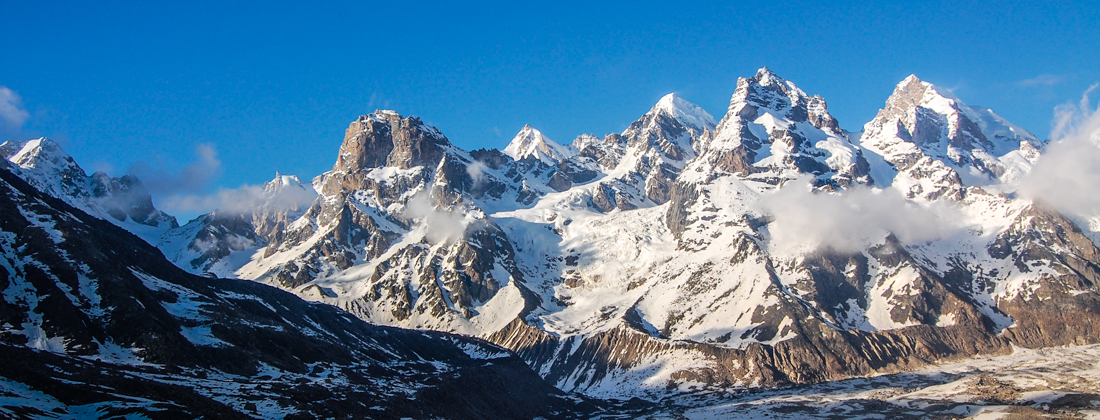
Himalayas
High mountains – Trekking – Jeep safaris – Culture – Temples – Centers of pilgrimage – Ashrams – Spirituality – Mythology – Hinduism – Buddhism – Yoga – Wildlife
Inside India organizes trips in the Indian part of the Himalayas, in Sikkim and in the Himalayan countries of Nepal and Bhutan.
The Himalayas, literally “abode of the snow”, is a mountain range with 14 peaks exceeding 8000 meters and several of the largest glaciers in the world. It extends over approximately 3000 km and separates the Indian subcontinent from Central Asia. Geologically, the Himalayas is a range of young, fold mountains that arose from a collision between the Indo-Australian Plate and the Eurasian Plate. The highest peak is Mount Everest at 8848m.
The immense mountain range begins in the west at the northern border of Pakistan, runs through the Indian states of Jammu and Kashmir, Himachal Pradesh, Uttar Pradesh and Sikkim, the Himalayan countries of Nepal and Bhutan and finally, its eastern foothills extend to Burma (Myanmar). The Tibetan Plateau forms the northern boundary of this mountainous area.
The Himalayas are associated with longing, dreams of travel and sporting challenges. Trekking is not the only way to explore the Himalayas, but it is very likely the most exciting, because one can experience the beauty of the high mountain world up close. In picturesque villages and on summer pastures, you meet local mountain farmers and join pilgrims, sadhus and monks on their way to the holy places, and through this direct contact with the country and its people, experience the cultural and religious diversity of the region.
There are established paths and routes in almost all regions, connecting the villages. You will trek through adjacent pastures and higher mountain passes commonly used by mountain people traveling from one valley to the next. The paths and mountain passes generally do not require special skills or equipment. There are however some treks that can only be mastered with mountaineering expertise and professional equipment, such as the trek to the Nanda Devi Sanctuary or routes crossing several high mountain passes that require special equipment to get across the glacier.
For those who prefer not to travel on foot, there are plenty of opportunities to explore the Himalayas by jeep. Multi-day jeep safaris include visits to monasteries and temple sites and drives through mountain passes with spectacular views of snowcapped peaks. For more extravagant travel plans, helicopters and aircraft can be made available. With its breathtaking downhill runs for skiing and snowboarding over endless expanses of snow, the Himalayas are also an increasingly popular destination for winter sports enthusiasts.
Trekking in the Indian part of the Himalayan region is a popular holiday activity that can be tailored to specific individual requirements. The spectrum ranges from short hikes to remote mountain villages and spectacular vantage points to multi-day treks with local mountain guides and porters to carry the luggage. There are rural settlements in almost every Himalayan valley and the mountain people are traditionally very hospitable, adding to the pleasantness of a trek.
In secluded Ladakh, the “land of high passes”, the capital Leh serves as the starting point for trekking tours and visits to monasteries. The barren mountain steppe landscape is marked by traces of extreme drought. Buddhism is the main religion here and visits to ancient monasteries are an absolute highlight, especially as they are freely accessible to tourists. Attractions include the various monastic festivals with their colorful mask dances.
The Garhwal region, an area with magnificent landscapes, is where the headwaters of the sacred Ganges are waiting to be discovered among breathtaking natural beauty and countless Hindu centers of pilgrimage. The most popular route goes via Rishikesh, an important Indian center for yoga and meditation, to the mountain village of Gaurikund and on to the sacred pilgrimage town of Kedernath.
The mountain town of Dharamsala, with the adjacent suburb and “hill station” McLeodganj, is the Indian residence of the Dalai Lama and a famous tourist center in the Indian state of Himachal Pradesh. Several thousand Tibetan exiles have found refuge here and have established a traditional Tibetan community with different centers of Tibetan culture. The area has some inviting trekking routes.
Sikkim, which opened its borders for a limited volume of tourism, also enthralls with its lush vegetation and the paradise-like mountain atmosphere of the eastern Himalayas. Around the imposing Kanchenjunga, the third largest mountain in the world, the traveler is greeted by gorgeous mountain scenery with mountain rivers, turquoise lakes, rice terraces, orange groves and pine forests.
